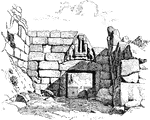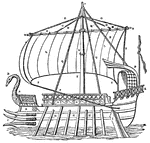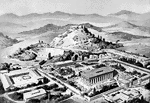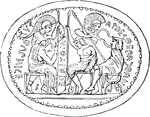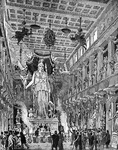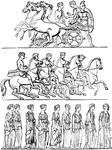The Ancient Greece ClipArt gallery offers 362 illustration of Greek history, events, and scenes of everyday life. For related images, please see Greek Mythology, Greek Architecture, Greek Ornament, Greek Coins, Greek Vases, and the Ancient Greek Musical Instruments ClipArt galleries.

Lorica
"A cuirass. The cuirass was worn by the heavy-armed infantry both among the Greeks and Romans. The soldiers…

Lorica
"A cuirass. The cuirass was worn by the heavy-armed infantry both among the Greeks and Romans. The soldiers…

Lucerna
"An oil lamp. The Greeks and Romans originally used candles; but in later times candles were chiefly…
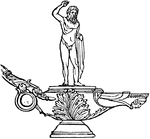
Lucerna
"An oil lamp. The Greeks and Romans originally used candles; but in later times candles were chiefly…

Lyre
"Cithara or Phorminx, from a vase in the British Museum. Best period of Greek art." —The Encyclopedia…
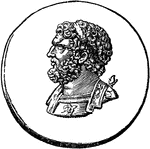
Philip of Macedon
Philip became king of Macedonia in 359 B.C. He was viewed as he best educated man of his time.
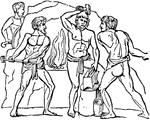
Malleus
"A hammer, a mallet. In the hands of the farmer the mallet of wood served to break down the clods and…

Man with ax
"Who brandishing aloft the ax of doom, That just has laid one victim at her feet, Looks round her for…

The Mound at Marathon
"Near the southern extremity of the plain of Marathon rises a conical mound, 30 feet high. it covers…
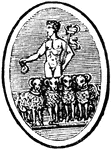
Marsupium
"Marsupium, a purse. The purse used by the ancients was commonly a small leathern bag, and was often…
Comedy masks
"While Greek tragedt grew farther and farther away from the humor and burlesque so characteristic of…
Tragedy masks
"Tragedy masks. The origin of Greek drama is to be found in the yearly celebrations in honor of Dionysus,…
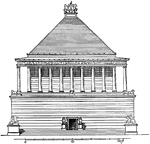
Mausoleum at Halicarnassus
The Mausoleum at Halicarnassus was a tomb built between 353 and 350 BC at Halicarnassus (present Bodrum,…
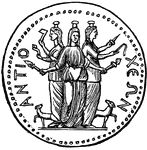
Medal of Antioch
A medal of Antioch engraved with an image of Nemesis, the goddess of divine punishment.

Medal of Attalia
A medal of Attalia. One side pictures Neptune with his trident, suggesting that Attalia was a seaport.…
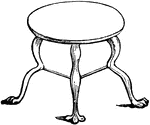
Mensa
"The simplest kind of table was a round one with three legs. It is shown in the drinking scene painted…
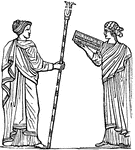
Mitra
"An eastern head-dress, sometimes spoken of as a characteristic of the Phrygians. It was also the name…

Tomb at Myra
"The second class, those cut in the rock, have either sculptured facades, or a kind of frame standing…

Nebris
"A Nebris is a fawn's skin, worn originally by hunters and others, as an appropriate part of their dress,…
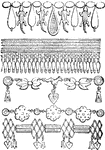
Ancient necklaces
"The following, also, are specimens of other ancient necklances. The first, small golden lizards alternate…
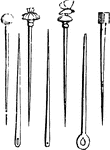
Needles and pins
"Needles and pins, chiefly aken from originals in bronze, vary in length from an inch and a half to…

Temple of Neptune
"Paestum, the Greek Poseidonia, was a colony of Sybaris. The malarial atmosphere of the place led to…

Nudus
"These words, besides denoting absolute nakedness, were applied to any one who, being without an Amictus,…

Ocrea
"A greave, a leggin. A pair of greaves was one of the six articles of armour which formed the complete…

Ocrea
"A greave, a leggin. A pair of greaves was one of the six articles of armour which formed the complete…

Victors at the Olympic Games
"From a very remote period, the Greeks had been accustomed to engage in contests of strength and agility…

Oscillum
"A diminutive through osculum from os, meaning "a little face," was the term applied to faces or heads…

Palium
"The English cloak, though commonly adopted as the translation of these terms, conveys no accurate conception…
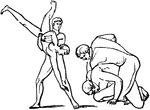
Pancratium
"An athletic game, in which all the powers of the fighter were called into action. The pancratium was…

Parthenon
The Parthenon is a temple of the Greek goddess Athena, built in the 5th century BC on the Athenian Acropolis.…

Parthenon
"The Parthenon is a celebrated temple at Athens, consecrated to Athena or Minerva, the protectress of…
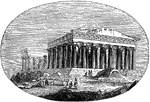
Modern Parthenon
"The Athenians, on their return to Attica, after the defeat of the Persians, found their city ruined…
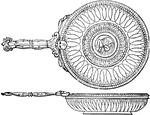
Patera
"The patera was a broad and comparatively shallow bowl used for libations, and also for drinking out…

Patera
"A round plate or dish. The paterae of the most common kind were small plates of the common red earthenware,…
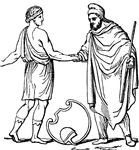
Pedum
"A shepherd's crook. On account of its connection with pastoral life, the crook is often seen in works…
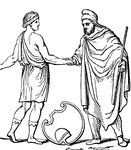
Pelta
"A small shield, Iphicrates, observing that the ancient Clipeus was cumbrous and inconvenient, introduced…
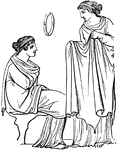
Peplum
"An outer garment, strictly worn by females, and thus corresponding to the himation or pallium, the…
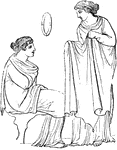
Peplus
"The peplus was a shawl which commonly formed part of the dress of females. It was often fastened…
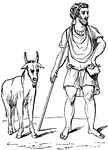
Pera
"A wallet, made of leather, worn suspended at the side by rustics and by travellers to carry their provisions,…

Periscelis
"An anklet or bangle, worn by the Orientals, the Greeks, and the Roman ladies also. It decorated the…
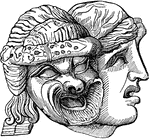
Persona
"A mask. Masks were worn by Greek and Roman actors in nearly all dramatic representations. This custom…

Persona
"A mask. Masks were worn by Greek and Roman actors in nearly all dramatic representations. This custom…




